 |
| Scott Adkins in action in One Shot |
If you’re not familiar with the work of actor and stunt performer Scott Adkins, the chances are that you have seen it nonetheless. He’s tremendously prolific, having appeared in everything from Eastenders to Zero Dark Thirty, The Expendables 2, Chinese blockbuster The Wolf Warrior, and Marvel’s Doctor Strange (in which he accidentally punched Benedict Cumberbatch for real). He’s recently been getting more prominent leading roles and is currently starring in One Shot as the leader of a squad of Navy SEALs charged with picking up a valuable detainee from a holding centre – a job which becomes considerably more complicated when the centre is invaded by terrorists. Framed as a single sequence, it’s a full on action spectacular and a real test for Scott, who has to run and fight almost continually for much of the running time.
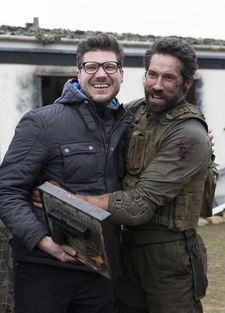 |
| James Nunn and Scott Adkins on set |
When we met up to discuss the film, along with his upcoming work in John Wick: Chapter 4 and Day Shift, I told him that, with the exception of Crazy Samurai Musashi, I’ve yet to see a heavy duty action film constructed this way. What prompted him to take it on?
“Me and James Nunn, the director, were finishing a film called Eliminators, and that's when we started discussing the idea of doing an action film in one take,” he says. “This was 2015, and it took us six years to get it done and get it out there. To be honest, when 1917 came along it was a bit like, ‘Oh, that’s that then – everyone’s just going to think we’re copying that. Maybe we better leave it.’ But Ben Jacques, the producer, and James persisted, and the script went through quite a few iterations. The tone of the movie changed to something more darker and serious, for the better. And I couldn't be more proud of the movie. And I think the story that we have works perfectly well in this conceit of the one continuous shot. I think it really helps. Some people say it's a gimmick, but I think for this particular movie, and what the story is, I think it really, really lends itself to it.”
How many takes were needed to get it right?
“Well, here's the thing: on one day, you're probably scheduled to do, like, ‘Okay, we're doing a six minute take today. That's all we've got to do,’ or maybe eight minutes, 10 minutes, whatever it is. And so you rehearse it, the first part of the day. And then everyone goes to lunch, and I'm there thinking, ‘Well, I'm not going to eat much of a lunch because I'm going to get sluggish and I've got to perform after that.’ So I have a little bit of something. And then you come back after lunch, and you continually trying to get the perfect version of that shot. Sometimes you get 20 seconds in and you've blown it. And then other times, you go all the way through, but you know that even if you get one that's perfect...” he pauses. “James was never satisfied. It's like ‘Oh, we're going to try and get one better now.’ And so you would just do it till the end of the day. There was no early days, no ‘Oh, we've got it. Let's go home.’ We kept going. And it always turned out that the light was perfect at the end of the day when the magic happens. And they always try and get a real good take for that, for when the light was just right.”
Did he get many breaks?
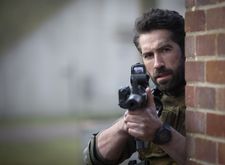 |
| Lining up a shot |
“You come in in the morning and you’re rehearsing for that shot, or maybe you’ve got more than one shot. But this was one of the most exhausting things I've ever done,” he says. “Because you don't know which take is going to be the take that ends up being in the movie. So in a normal film, you've got the cameras over your shoulder, and I want to give the actor the best performance and not be a selfish actor so I'm going to give you as much as I can. But you can kind of take your foot off the pedal a little bit and calm down. But you never knew which take was going to be the one that is in the film. So you gave it everything you had every time, and that was just for the acting. Then there’s doing all the action. All the bumps and bruises that went on at the time. It wasn't easy.”
Does it affect safety as well, when so much needs to be coordinated at once?
He shrugs. “It's never too safe. I mean, when you're dealing with vehicles and explosions and stuff. But if it's a fight scene, I mean, that's part of the job. You're often getting punched in the face when you weren’t supposed to and vice versa, you know. That's part of the job.”
It seems to me that there's a bit of a tension there when one wants to get absorbed in a character as an actor, but then as a stunt performer, one needs to be following exactly what's happening and where one is supposed to move, and not get carried away.
“The lines are being blurred now,” he says. “I think that stunt guys have become so good now at training actors to look professional in martial arts or in fight scenes, and become very aware of the camera tricks and the wire work and the CG and the face replacement, things that you might not even know about now, but on One Shot the action is very, very realistic. And it's me doing all that.”
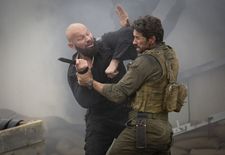 |
| UCF's Jess Liaudin takes on our hero |
Has the move to shooting on digital changed the way stunts are shot? Not in his experience, he says.
“I mean, you know, you could put a pad down and a green pad and maybe remove that in posts and make it a bit more comfortable. But in some of my movies they don’t even do that. They’re just bouncing off hard stairs and things. You just go until somebody pulls the camera away.”
He’s clearly pleased to be in the lead this time around, but takes a relaxed approach to choosing roles.
“I like to be the star. I like to be the baddie. I like to be a supporting actor. I like to come in and do a cameo. I don't mind that. I like to work. I love my job, I’m pretty much open to anything.”
And people talk about the importance of having a certain look in action films. I know some actors dehydrate themselves to make their muscles stand out more, but obviously one can't do that kind of thing when performing stunts. How does he get that balance?
“Yeah, you're right, you can't do that. Because on the one hand, you want to look really good on camera, but you've got to do a fight scene for all day long, or for three days, and if you're doing that to yourself, you're going to be in big trouble. So you’ve just got to be healthy, physically fit, like a fighter, ready to ready to put your body through the motions. And, you know, you are going to get injured. It isn't going to be easy but you just get on with it. I mean, sometimes you can plan to get your body into a certain condition for a particular shot. Like if I know I'm taking my top off on this day, then I could maybe build up to that and dehydrate myself for that specific shot.”
We discuss the process of directing and choreographing scenes, and how he participates in that as a performer.
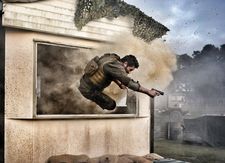 |
| You can only be so safe with explosions. |
“When it comes to the action I’m extremely involved,” he says. “Sometimes I'm lucky enough to have someone like Tim Man, who did One Shot and was the fight coordinator on many of my other movies. I can rely on him and relax. And other times, I feel the need to take over and make sure it's up to my standards. One thing I think I can confidently say is that you won't see one of my films with bad action sequences.”
It’s also, clearly, about the relationship that develops between the performers, so that they can anticipate and trust one another.
“Yeah, absolutely. Because if I'm with someone who's not remembering the moves, I can't fully commit and throw everything at him. Because when he throws a punch and I’m meant to duck it, I need to know that he's coming at the correct time so that I can duck it within inches. But if his timings off, then I'm a little bit nervous because you know, don't want to get hit in the face. When you’re with a partner that you feel really instinctual, you know, everything just gets easier.”
And then there’s that tension then with acting because it’s hard to maintain a consistent look when one is getting punched in the face from time to time.
“I had to cover up some bruises on Sunday in a film called Ninja,” he laughs. “I got hit in the head with the butt of a sword and literally in the movie, you can see it – they put as much make-up on as they could but I had a big egg on my face so it didn't look great.”
I know he’s an admirer of Keanu Reeves, so I ask what it’s like to be working with him on John Wick: Chapter 4, and he beams.
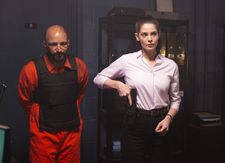 |
| One Shot co-stars Waleed Elgadi and Ashley Greene |
“Brilliant. I love Keanu even more now. He’s just a fantastic guy. God, he works hard. Never complains, just gets on with it. And I love that. And you can tell from watching the movies, you can't have a film with a guy like him in it, when there's that much action, and he does so much of it himself, you know – you've got to be made from a cut from a different cloth to be able to do that much action.”
How did he feel stepping into a franchise like that?
“Oh, I absolutely loved it. I love the John Wick films. They're the best action films and there is no action film franchise at this very moment better than John Wick.”
The cinematography in them made a big impression on me, I say, and he agrees.
“It's not just the action. I mean, Dan Laustsen the cinematographer, some of the sets that we have on the new one, he's just absolutely mind blowing. I've never seen anything like it. And I can't wait to see it.“
And there’s Day Shift, with Jamie Foxx, coming up as well.
“Yes. So JJ Perry is the director of Day Shift and we've gone back many years, he was fight coordinator, stunt coordinator and second unit director. Now director This is his first directorial début. And he asked me to be in it and I couldn't be happier I think it's going to do really well. It's action comedy horror.”
Is there time to do other kind of martial arts work alongside all those films?
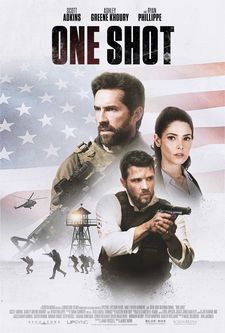 |
| One Shot poster |
“I train a lot, you know, I've got to keep in shape. Because obviously when they say ‘Do this character,’ or whatever, I need to be able to do it. If I haven't done it for six months, I might struggle putting myself in good condition. I can't say that I'm learning any new tricks right now. I'm just trying to keep the cogs oiled and ready to go.”
Do films give him the opportunity to learn from the people he finds himself working with?
“Absolutely. Doing martial arts films all my life, I’ve come into contact with some of the greatest martial artists that we've had on the planet. And I've been able to work and chat and train with UFC fighters to kung fu masters to all sorts of martial artists from all over the globe, so that's been one of the highlights of the job.”
So when he was a kid watching Bruce Lee films, did he ever imagine that he would be in this situation?
“I'll tell you what I imagined as a kid watching Bruce Lee. I thought ‘Man, I want to be like Bruce Lee when I’m older!’ And then as I grew up and I got my hair with chest, I realised that I was more of a Chuck Norris.” He laughs. “It took me a while to get over it, I'll tell you that. But Bruce Lee is still the best.”
He’s now preparing to appear in Accident Man 2, which he co-wrote and produced and which has suffered delays due to the pandemic. “It’s dear to my heart,” he says.
One Shot is available in US cinemas and on demand from Friday, 5 November.





















